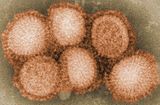
Pandemrix

Pandemrix is an influenza vaccine for influenza pandemics, such as the 2009 flu pandemic. The vaccine was developed by GlaxoSmithKline and patented in September 2006. Pandemrix is an influenza vaccine for influenza pandemics, such as the 2009 flu pandemic. The vaccine was developed by GlaxoSmithKline and patented in September 2006. The vaccine is one of the H1N1 vaccines approved for use by the European Commission in September 2009, upon the recommendations of the European Medicines Agency (EMEA). The vaccine is only approved for use when an H1N1 influenza pandemic has been officially declared by the World Health Organization (WHO) or European Union (EU). The vaccine was initially developed as a pandemic mock-up vaccine using an H5N1 strain. In August 2010, The Swedish Medical Products Agency (MPA) and The Finnish National Institute for Health and Welfare (THL) launched investigations regarding the development of narcolepsy as a possible side effect to Pandemrix flu vaccination in children, and found a minimum 6.6-fold increased risk among children and youths, resulting in a minimum of 3.6 additional cases of narcolepsy per 100,000 vaccinated subjects. As well as the active antigen derived from A/California/7/2009 (H1N1), the vaccine contains an immunologic adjuvant AS03 which consists of DL-α-tocopherol (vitamin E), squalene and polysorbate 80. Thiomersal (thimerosal) is added as a preservative. Being manufactured in chicken eggs, it contains trace amounts of egg proteins. Additional important non-medicinal ingredients are formaldehyde, sodium deoxycholate, and sucrose. While other 2009 H1N1 vaccines have been developed, the use of a proprietary immunologic adjuvant is claimed to boost the potency of the body’s immune response, meaning that only a quarter of the inactivated virus is needed. Professor David Salisbury, Head of Immunisation at the UK Department of Health said the vaccines with adjuvants offer good protection even if the virus changes over time; 'One of the advantages with adjuvanted vaccines is their ability to protect against drifted (mutated) strains. It opens the door for a whole new strategy in dealing with flu.' The vaccine is supplied in separate vials, one containing the adjuvant, and the other the inactivated virus, which require mixing before intramuscular injection. Originally it was thought that two doses given 21 days apart would be required for full efficacy. Subsequent testing has allowed the UK programme to consist of just a single dose for most people, with a two-dose schedule for children under the age of 10 years and immunocompromised adults. As of 3 December 2009, 11.2 million doses of Pandemrix had been delivered to health services in the UK, where the vaccine forms the bulk of the government's mass vaccination programme.
